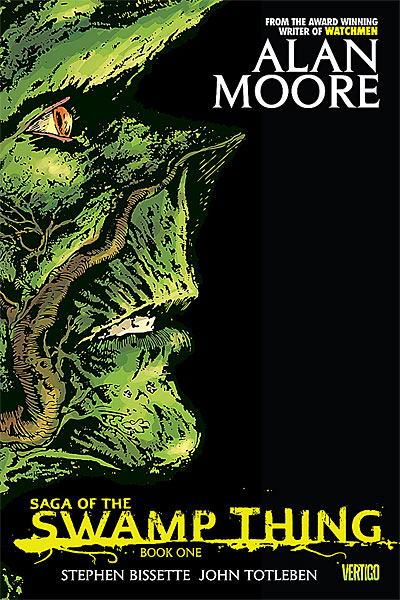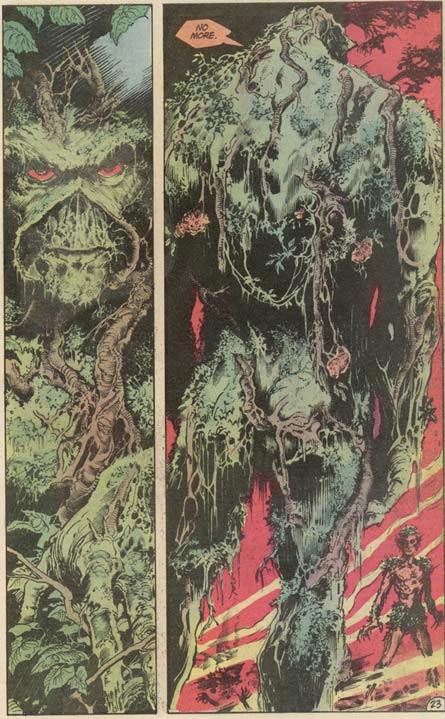- Comics
- Comics Reviews
- Manga
- Comics Reviews
- European Comics
- News
- Comics News
- Press Releases
- Columns
- Spotlight
- Digital Comics
- Webcomics
- Cult Favorite
- Back Issues
- Webcomics
- Movies
- Toys
- Store
- More
- About
By Andy Frisk
March 7, 2009 - 23:10
Alan Moore’s first work for DC was on Saga of The Swamp Thing. Moore took over with issue 20 of the series in 1983. His run on Saga of The Swamp Thing turned out to be one of the most celebrated of comic book writers’ runs, and helped give Moore the chance to be allowed the creative freedom to create other works, such as the highly revered Watchmen mini-series, subsequently collected, and recollected in several editions.
 |
When Moore took over Saga of The Swamp Thing he asked permission of Len Wein, one of Swamp Thing’s creators, if he could make some changes to the character. After getting permission, Moore sets out to make these changes, and gave us a tale of the “rebirth of The Swamp Thing,” which starts immediately at the end of issue 20 when he apparently kills off Swamp Thing. As we, along side Alec Holland, aka Swamp Thing, find out though, Swamp Thing/Holland cannot really be killed by conventional means since 1) Alec Holland is already dead, and the super enhanced plants powered by the bio-restorative formula that compose Swamp Thing’s body only carry the consciousness of Holland, therefore making Swamp Thing a hybrid of human consciousness and a plant life being with no human (or “meat,” as humans are oft referred to in this collection) components and 2), that this realization drives Holland back to the Bayou swamps to give up the ghost as it were, and simply devolve back into vegetable life. Holland/Swamp Thing nearly completes this desire until the scientist, Jason Woodrue, aka the villainous Floronic Man, hired by Swamp Thing’s “murderers” to unlock his plant power secrets, attempts to use the secret of Swamp Thing’s origin to gain power over mankind. Woodrue taps into Swamp Thing’s plant communicative power with disastrous results causing Swamp Thing to rise up to defend both plant and human life. Sound complex and confusing? Welcome to the world of Alan Moore storytelling.
Its a great story though, and worth the time it takes to read and digest it. As Moore so often does thematically in his tales, he brings together opposing viewpoints and differing world views, mixes them together, shows the pro’s and con’s of each, and leaves the readers to decide what lessons, ideas or “morals of the story” to take with them. In Watchmen we got the differing viewpoints on compromising ones’ values or speaking out and using ones’ power and ability to affect the world we live in, justly or unjustly. In these early Saga of The Swamp Thing tales, we get a conflict between a plant who thinks he’s a man, and wants his full humanity back, and a man who thinks he’s a plant, and wants to be divested of his humanity. Swamp Thing ends up being the human consciousness that is helped and bettered by “the green,” as the plant world is called, in the series, and Woodrue ends up being the plant that nearly destroys the Earth by tainting “the green” with an extremist human consciousness. All of this is, of course, a metaphoric tale warning of the dangers of inaction in the face of extremist action, and extinction vs. co-existence, a theme that is recurring in most of his works from the 1980’s, which were written in the shadow of the Cold War, where nuclear war and mutually assured destruction were constant threats.
The edition doesn’t end with Swamp Thing’s rebirth and adjustment to the new reality of his origin. We get a tale involving Jason Blood, The Demon and the supernatural as well. Both tales have some great artwork, particularly some very iconic drawings of Swamp Thing that remain definitive to this day. In particular page 16 of the collected issue #23 and page 23 of the collected issue #24. The detail that goes into the depiction of the foliage, moss, mud and twisted roots that compose Swamp Thing’s body is a treat to behold, as is the horror elements penciled in where the story, particularly the Demon story, call for it. All of the original covers are reproduced at the start of each collected issue, including the Comic Code Approved logo, number, month and year of the issue and the… sigh…$.75 cover price. Oh, the days when pocket change could buy you a wealth of great art and storytelling! A drawback to the edition is the barely better than news paper stock paper the issues are reprinted on. The awesome hardback cover embossed with Swamp Thing’s face almost makes up for it, but the dust jacket is strangely sticky due to the printing process. We also get issue #20, reprinted for the first time in any collection of Moore’s Swamp Thing tales so this edition can truly, if not really necessarily, claim completion. Perhaps by the time Book II comes out the deficiencies will be corrected.
 |
Overall, with Alan Moore and his works, no matter how much he might not like it, getting loads of attention now that Watchmen the movie is a reality, readers wanting to pick up more by the bearded and long haired author of the graphic novel which lead to the above mentioned movie wouldn’t go wrong picking up Saga of The Swamp Thing: Book One. It’s well worth the read.
Rating: 9.5 /10